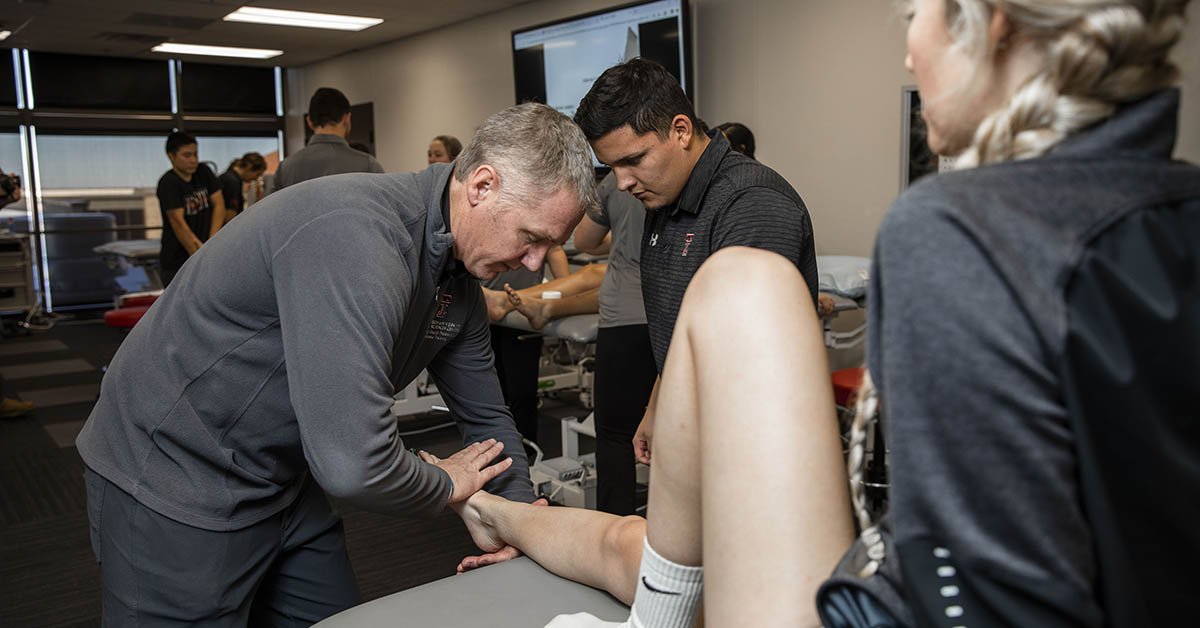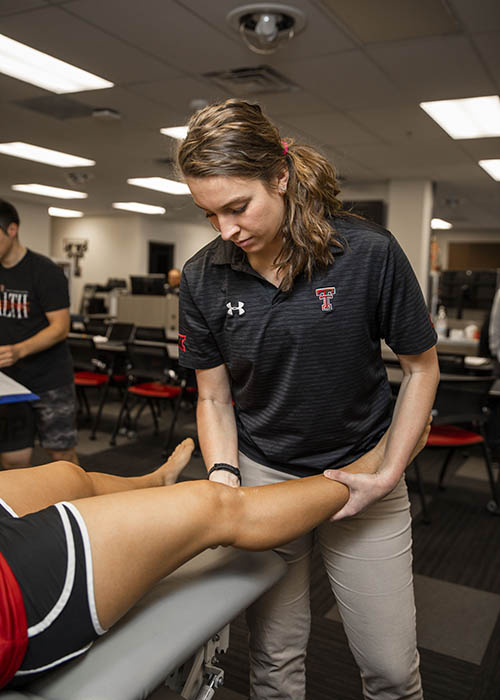Celebrating National Athletic Training Month
During the month that recognizes athletic trainers, we dive into their diverse roles. Spoiler alert: Athletic trainers treat many types of patients, not just athletes.

March is National Athletic Training Month, with the goal of spreading awareness about the important work being done by athletic trainers. The 2022 slogan is, “Providing Healthcare Everywhere.”
We spoke with Larry Munger, PhD, LAT, ATC, an assistant professor in the Masters of Athletic Training program of the TTUHSC School of Health Professions, about the role of an athletic trainer.
Athletic Trainers: Providing Healthcare Everywhere
Despite the title, athletic trainers work with all types of patients, including the military and in corporate industrial settings, like Amazon or General Motors.
“Athletic trainers will work in the organization to do regular checkups and movement testing,” Munger explains. “If someone complains about aches and pains, they will do testing to reduce the chance for further injury and work loss.”
Movement Testing For All

Munger explains that there are many different screening tests for injuries that involve pushing, pulling, squatting, lifting and any other movement common to the workplace or vocation.
“If someone complains of being hurt, you have to first identify the movement that is hurting before you can implement strategies to help them,” Munger says.
Munger says that the most common movement screen is called FMS, which stands for Functional Movement Screening and was developed by Gray Cook beginning in 1995.
“The screening includes an overhead squat, inline lunge, trunk stability and a leg raise test,” Munger explains. “Their thought process is that it’s like taking blood pressure; they are identifying common movement patterns.”
The fundamental difference between treating athletes and non-athletes is identifying what the patient’s movement demands are. Specific sports call for specific treatment and movement screening. It’s also important to do a sport or work analysis profile, which outlines the job demands as well as home life.
Reducing Injury During Exercise
Preventing injuries is better than treating them. To reduce injuries, Munger recommends starting slow with any fitness program you’re going through.
“Work on the basic movements,” he says. “Anytime you’re starting an exercise program or becoming more active, understand that you can’t do it all at once and it will take time.”
It’s also important to understand the difference between joint pain and muscle soreness.
“Joint pain will be within the joints and often more localized, while muscle soreness occurs in the main part of the muscle that is sore,” he says.
Working in different planes of movement is a good way to avoid injury by not putting too much strain on any one muscle or joint and maintaining mobility.
The Importance of Staying Active
How many of us made a New Year’s resolution to get in shape or lose weight only to go too hard, causing injury or severe soreness?
“You need to continue to stay active when sore and identify the movements or exercises that don’t hurt or cause pain,” Munger recommends.
Simply beginning with walking is a great place to start, he says. Eventually, you can add some jogging, perhaps half a block. The important thing is to not give up on being active and progress slowly.
“Find something to do everyday,” Munger says. “It doesn’t have to be a lot. Maybe do one squat every time you brush your teeth, or at a set time every day. Over time you can increase the amount of exercise and continue to stay active.”
*Image: TTUHSC MAT alum Erin Earhart (Class of 2021) performs a knee evaluation on a patient. Now an Assistant Athletic Trainer at Methodist University in Fayetteville, NC, Erin completed a summer internship with the Buffalo Bills in2020 while still a student in the MAT.
Related Stories
Celebrating Veterans: TTUHSC’s General Martin Clay’s Legacy of Service and Leadership
From his initial enlistment in the Army National Guard 36 years ago to his leadership in military and civilian health care management roles, Major General Martin Clay’s career has been shaped by adaptability, mission focus and service to others.
Texas Tech University Health Sciences Center School of Nursing Named Best Accelerated Bachelor of Science in Nursing Program in Texas
The TTUHSC School of Nursing Accelerated Bachelor of Science in Nursing (BSN) program has been ranked the No. 1 accelerated nursing program in Texas by RegisteredNursing.org.
TTUHSC Names New Regional Dean for the School of Nursing
Louise Rice, DNP, RN, has been named regional dean of the TTUHSC School of Nursing on the Amarillo campus.
Recent Stories
Making Mental Health a Priority in the New Year
Sarah Mallard Wakefield, M.D., a psychiatrist with Texas Tech Physicians, talks about strategies to combat widespread and growing anxiety.
TTUHSC Cancer Researcher Honored by National Academy of Inventors
C. Patrick Reynolds, M.D., Ph.D., director of the School of Medicine Pediatric Cancer Research Center at TTUHSC, has dedicated his life as a researcher to developing treatments for childhood cancers.
TTUHSC School of Nursing Celebrates 10 Years of the Veteran to BSN Program
The TTUHSC School of Nursing recognized the 10-year anniversary of the Veteran to Bachelor of Science in Nursing (VBSN) program during the fall 2025 commencement ceremonies held Dec. 13 in Lubbock, Texas.
